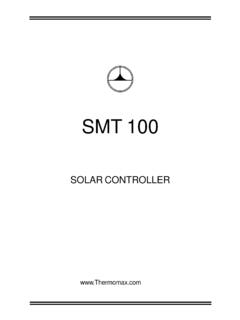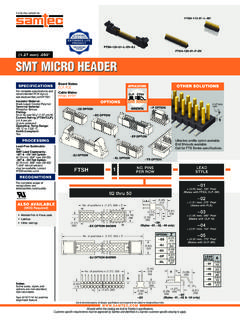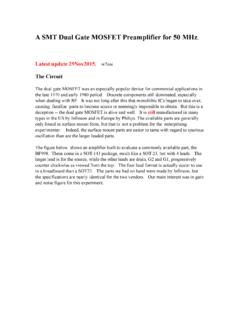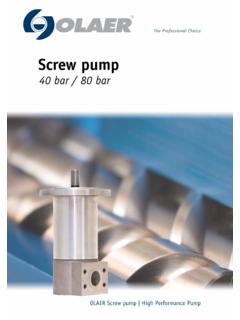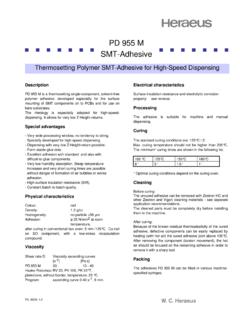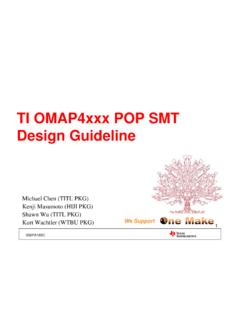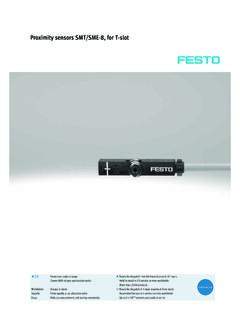Transcription of Semiconductor Packing Methodology (Rev. C)
1 Application ReportSZZA021C September 20051 Semiconductor Packing MethodologyCles Troxtell, Bobby O Donley, Ray Purdom, and Edgar ZunigaStandard Linear & LogicABSTRACTThe Texas Instruments Semiconductor Group uses three Packing methodologies to preparesemiconductor devices for shipment to end users. The methods employed are linked to thedevice level for shipping configuration keys. End users of the devices often need to perusemany TI and industry publications to understand the shipping configurations. This applicationreport documents TI s three main shipping methods and typical dimensions for end users .. Background3.. Typical Applications of Each Packing Method5.. Stick Magazine (Shipping Tube) Primary Component Container5.. Tray Primary Component Container8.. Tape and Reel Primary Component Container10.. Moisture Sensitivity20.. Testing for Moisture Sensitivity20.. Dry- Packing Process21.
2 Dry Packing21.. Typical Packing Method21.. Conclusion26.. Glossary27.. Acknowledgment28.. References28.. SZZA021C2 Semiconductor Packing MethodologyList of Figures1 Single-Stick-Magazine Shipping Tube3.. 2 JEDEC Tray3.. 3 Reel With Carrier Tape4.. 4 Intermediate Packing for PDIP Packages5.. 5 Example of Trays Stacked and Bound8.. 6 JEDEC Tray With Properly Arranged Units9.. 7 Tape-and-Reel Packing10.. 8 Carrier-Tape Dimensions11.. 9 Carrier Tape Pocket Quadrant Definition14.. 10 Rectangular QFP Package Properly Oriented in Carrier Tape15.. 11 EIA-783 Guideline, Rules 1 and 216.. 12 EIA-783 Guideline, Rule 316.. 13 Typical TI Component Orientations for Tape-and-Reel Packing17.. 14 Typical Reel Outline as Defined by EIA-481-x18.. 15 Loaded Reel (Not Moisture Sensitive)19.. 16 Standard Box Containing Loaded Reel19.. 17 Tray Box and Sealed Moisture-Barrier Bag (Top), Opened Bag and Tray Stack (Bottom)22.
3 18 Dry-Packed Tape-and-Reel Configuration23.. 19 Moisture-Sensitive Identification (MSID) Label24.. 20 Moisture-Sensitivity Caution Label (Levels 2a Through 5a)24.. 21 Humidity-Indicator Card25.. List of Tables1 Stick Magazine6.. 2 SLL Packages and Standard Quantities9.. 3 Tape-and-Reel Packing Configurations12.. 4 Floor Life for Different Package Moisture-Sensitivity Levels21.. 5 Packing -Material Environmental Coding25.. SZZA021C3 Semiconductor Packing MethodologyIntroductionThis application report describes in detail the methods used by the TI Standard Linear & Logic(SLL) business unit to pack Semiconductor devices (components). This application reportprovides customers answers to the most frequently asked questions and allows them to reviewthe different methods used to pack our ships product in three basic configurations: stick magazine, tray, and tape and reel.
4 Thefollowing paragraphs define each Packing configuration. Stick magazine The stick magazine (also called shipping tube) was developed in the earlydays of the integrated circuit (IC) industry. The magazine is used to transport and storeelectronic components between the manufacturer and the customer and for use in themanufacturing plant. Magazines also are used to feed components to automatic-placementmachines for surface and through-hole board mounting. Multiple stick magazines are placedin next-level intermediate containers (boxes and bags) in standard Packing quantities. Atypical stick magazine is shown in Figure 1. Stick Magazine Tray The IC shipping tray contains the components during component-assemblyoperations, during transport and storage from the component manufacturing plant to thecustomer s board-assembly site, and when feeding components to automatic-placementmachines for surface mounting on board assemblies.
5 The tray is designed for componentsthat have leads on four sides (QFP and TQFP packages) and require component leadisolation during shipping, handling, or processing. Trays are stacked and bound together toform standard Packing configurations. SLL uses only standard JEDEC tray configurations. Atypical JEDEC tray is shown in Figure 2. JEDEC TraySZZA021C4 Semiconductor Packing Methodology Tape and reel The tape-and-reel configuration is used for transport and storage from themanufacturer of the electronic components to the customer, and for use in the customermanufacturing plant. The configuration is designed for feeding components toautomatic-placement machines for surface mounting on board assemblies. The configurationcan be used for all SMT packages and provides component lead isolation during shipping,handling, and processing. The complete configuration consists of a carrier tape withsequential individual cavities that hold individual components, and a cover tape that sealsthe carrier tape to retain the components in the cavities.
6 In most cases, single reels ofcomponents are inserted into intermediate boxes before shipping. A typical loaded reel isshown in Figure 3. Reel With Carrier TapeSZZA021C5 Semiconductor Packing MethodologyTypical Applications of Each Packing MethodStick Magazine (Shipping Tube) Primary Component ContainerStick magazines are constructed of rigid clear or translucent polyvinylchloride (PVC) magazines are extruded in applicable standard outlines that meet current industrystandards, and protect components during shipping and handling. The stick-magazinedimensions provide proper component location and orientation for industry-standardautomated-assembly magazines are packed and shipped in multiples of single magazines. Multiple stickmagazines are loaded into intermediate containers (bags and boxes) to form standardquantities, for ease of handling and order simplification. Typical intermediate-level packingquantities for magazines vary by pin count and package type.
7 Figure 4 shows intermediate-levelpacking for PDIP packages. Stick magazine Packing quantities are included in Table 4. Intermediate Packing for PDIP PackagesSZZA021C6 Semiconductor Packing MethodologyTable 1. Stick MagazinePackageTypePin-CountPackageDesig natorQuantityPerMagazineContainerStandar dQuantitySectional Shape(mm)MagazineLength(mm)WallThickness (mm)Pin or PlugShape and Dimensions(mm)PDIP(300 mil)8 P14 N16 N20 N24 NT28 (600 mil)24 (JEDEC,narrow body)8 D14 D16 (JEDEC,wide body)16 DW20 DW24 DW28 (EIAJ)8 PS14 NS16 NS20 (narrow body,pitch 1 mm)28 DB30 DB38 DB505040100010001000 SSOP(wide body,pitch 1 mm)28 DL48 DL56 Semiconductor Packing MethodologyTable 1. Magazine (Continued)PackageTypePin-CountPackageDe signatorQuantityPerMagazineContainerStan dardQuantitySectional Shape(mm)MagazineLength(mm)WallThickness (mm)Pin or PlugShape and Dimensions(mm)TSSOP(narrow body,pitch 1 mm,max height mm)8 PW14 PW16 PW20 PW24 (wide body,pitch 1 mm,max height mm)48 DGG56 DGG64 (square)20 FN28 FN44 FN2696020 Pin28 Pin44 Pin28 Pin44 Packing MethodologyTray Primary Component ContainerTrays are constructed of carbon-powder or fiber materials that are selected according to themaximum temperature rating of the specific tray.
8 TI trays designed for use on componentsrequiring exposure to high temperatures (moisture-sensitive components) have temperatureratings of 150 C or are molded into rectangular JEDEC standard outlines, containing matrices of uniformlyspaced pockets. The pocket protects the component during shipping and handling. The spacingprovides exact component locations for standard industry automated-assembly equipment usedfor pick-and-place in board-assembly are packed and shipped in multiples of single trays. Trays are stacked and bound togetherfor rigidity. An empty cover tray is added to the top of the loaded and stacked trays. Typical traystack configurations are five full trays and one cover tray (5 + 1), and ten full trays and one covertray (10 + 1) (see Figure 5).Customers can receive units in single or multiple stacks, depending on individual 5. Example of Trays Stacked and BoundSZZA021C9 Semiconductor Packing MethodologyComponents are arranged in the trays to match industry standards.
9 TI standard orientation is toplace pin 1 at the tray chamfered corner (see Figure 6).Figure 6. JEDEC Tray With Properly Arranged UnitsStandard Packing quantities vary by package size. Table 2 lists SLL packages and their 2. SLL Packages and Standard QuantitiesPACKAGETYPEPACKAGEPINSQUANTITY PER TRAYMATRIXCONTAINERSTANDARDQUANTITYPM641 608 20800 TQFPPN801197 17495 TQFPPCA100906 15450PZ100906 15450 QFPRC52966 16480 SZZA021C10 Semiconductor Packing MethodologyTape and Reel Primary Component ContainerThe tape-and-reel configuration, as shipped by TI, meets current industry standards. EIA-481-1,EIA-481-2, and EIA-481-3 apply to the embossed configurations. EIA-468-B applies to theradial-lead-device Tape and ReelMost components ordered by customers are delivered in the embossed tape-and-reelconfiguration. This configuration consists of a carrier tape with a cover tape sealed to it (seeFigure 7).
10 This composite tape, loaded with the components, is wound on a reel. The reel isplaced in a corrugated shipping box for transport and three components of this Packing configuration are the carrier tape, the cover tape, and thereel. A description of each component is provided in the following TapeEmbossed CavityCarrier TapeBar-Code Label AreaFigure 7. Tape-and-Reel PackingSZZA021C11 Semiconductor Packing MethodologyCarrier TapeFigure 8 shows the basic outline and dimension labels of the carrier tape. Typically, the carriertape is constructed from a polystyrene (PS) or PS-laminate film. The uniform film thickness mm to mm, depending on the size and weight of the component carried by the WP1 CavityA0B0 Figure 8. Carrier-Tape DimensionsCarrier tape design is defined largely by the component length, width, and following component dimensions are the basis for common industry dimension variables forcarrier tape:A0 = Dimension designed to accommodate the component widthB0 = Dimension designed to accommodate the component lengthK0= Dimension designed to accommodate the component thickness.










